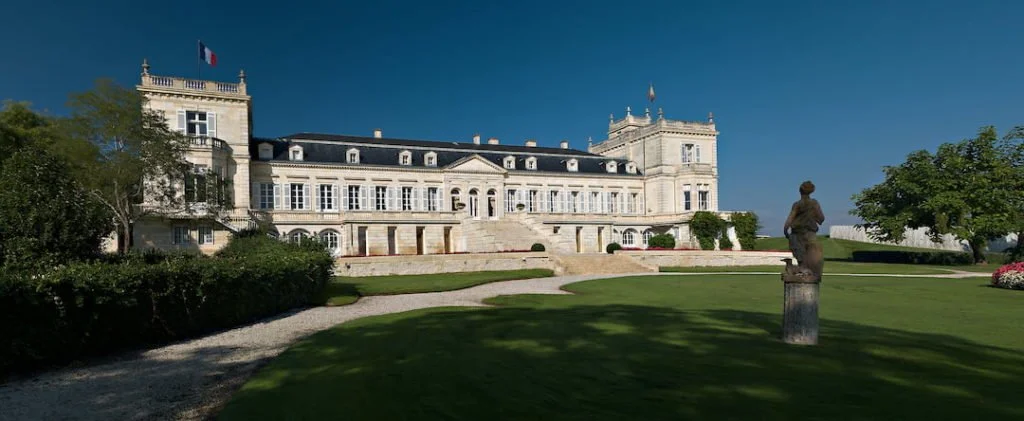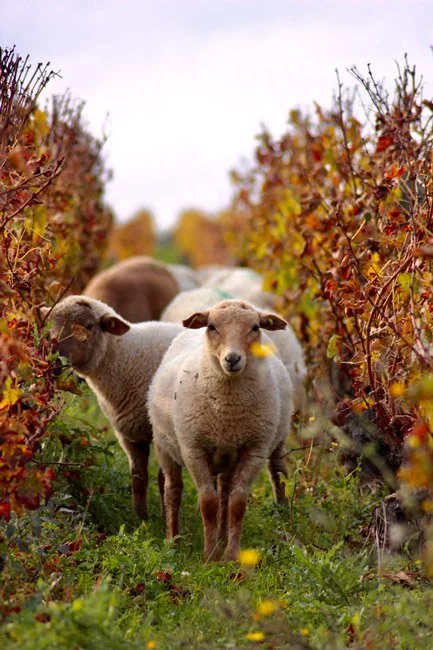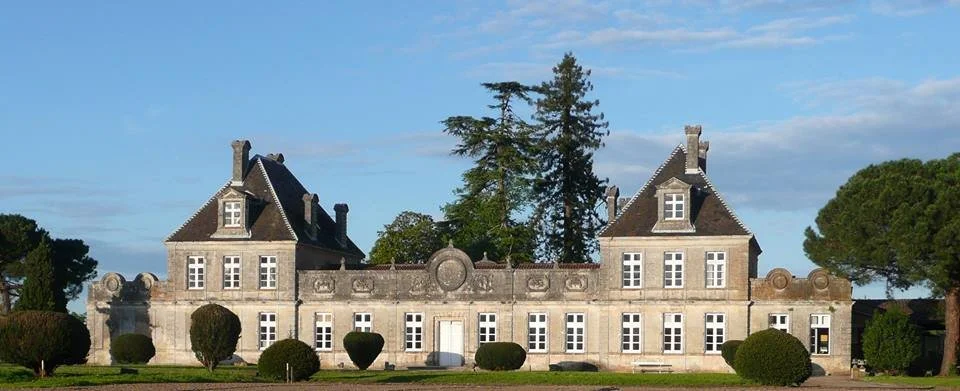“I can certainly see that you know your wine. Most of the guests who stay here wouldn’t know the difference between Bordeaux and Claret.
”
Bordeaux
Bordeaux, the vast region along the Dordogne and Garonne Rivers which conjoin at the city of Bordeaux to form the Gironde Estuary, is home to some of the world's most classic grape varieties. Best known for Cabernet Sauvignon and Merlot, the region is also home to Cabernet Franc, Malbec, Petit Verdot and Carmenere. For whites, the district produces wines from a blend of Sauvignon Blanc and Semilllon, often with a touch of Sauvignon Gris and/or Muscadelle.
Broadly, the region is divided into three primary districts: The Left Bank (Medoc and Graves) where Cabernet Sauvignon predominates, the Right Bank (Saint Emilion, Pomerol and various satellite appellations) where Merlot predominates and the primary Cab is Cabernet France, and the hilly region between the rivers Garonne and Dordogne, including Entre Deux Mers, Bordeaux Superieur and others.
Terroir's portfolio includes a range of Bordeaux wines, from basic Bordeaux Rouge to Graves and Saint Emilion, selected to represent the range of classic styles, and some of the best values in the region.
Our Estates
Medoc
Chateau Livran- AOC Medoc. Estate founded in 1284 by brothers Arnaud and Beraud de Goth, ancestors of the Bertrand de Goth, the Bishop of Bordeaux who became Pope Clement V (and owner of Chateau Pape Clement). Owned by the Michon family since 2013 who have been investing in a full rehab of vineyard and cellars, including a full conversion to biodynamic practices. Caberrnet/Merlot blend grown on clay/limestone soils. Vinification in concrete, elevage in 30% new oak.
Haut Medoc
Chateau Bernadotte (AOC Haut Medoc, Cru Bourgeois Superieur) is just outside the Pauillac appellation, and adjacent to Chateau Pichon Longueville Comptesse de Lalande. The vineyards lie on fine gravels and sands, planted to 51% Cabernet Sauvignon, 48% Merlot and 1% Petit Verdot. HVE-3 Certified.
Chateau Prieure de Beyzac- AOC Haut Medoc, Cru Bourgeois. Sustainable winemaking from Nadine & Eric Charlassier, working vineyards of 60% Merlot, 40% Cabernet Sauvignon- a bit unusual for the Haut Medoc. Sustainable, Lutte Raisonnee, HVE-3 Certified.
Chateau Cantemerle
From the famed Chateau Cantemerle, Les Allees de Cantemerle (AOC Haut Medoc) is a cuvee produced from younger vines and designed as a more approachable wine when young. Mostly Cabernet Sauvignon with 10-15% each Merlot and Cabernet Franc. The property is managed sustainably and is both a nature park and botanic garden, with some trees planted over 400 years ago.
Moulis-en-Medoc
Chateau Duplessis (AOC Moulis-en-Medoc, Cru Bourgeois) dates its origins to the 15th Century and the family of Cardinal de Richelieu. Owned since 2016 by Philippe Ferrier who is investing in a wholesale renovation of the vineyards and chais. 61% Merlot, 29% Cabernet Sauvignon, 8% Cabernet Franc, 1.5% Petit Verdot and 0.5% Malbec planted on a bedrock upwelling that brings limestone up to 50cm below the surface. The result is a complex and elegant wine, and is the reason Moulis has its own AOC.
Margaux
Chateau Deyrem-Valentin (AOC Margaux) was founded in 1730. Current owner Jean Sorge’s family has owned the estate since 1928, and today Jean manages the property with his two daughters, Christelle (lead oenologist) and Sylvie (business manager). 50% Cabernet Sauvignon, 49% Merlot and 1% Petit Verdot planted on deep gravel soils. HVE-3 Certified.
Saint Julien
Chateau du Glana (AOC Saint Julien) is situated on the Route des Grands Vins between the villages of Beychevelle and Saint-Julien, and directly across from Chateau Ducru-Beaucaillou. Owned since 1961 by the Meffre family, the current generations have undertaken a wholesale renovation, with new winery facilities and chais. The limestone gravel soils are planted to 65% Cabernet Sauvignon and 35% Merlot.
Chateau Ducru Beaucaillou in Saint Julien
Chateau Lagrange is one of the great estates of the appellation. A favorite of Thomas Jefferson, it’s today ranked as a Troiseme Cru. The present owner (since 1983) is the son of the founder of the Suntory distillery of Japan, who has poured millions into a full restoration of this great estate. Silky and bright, it’s everything a Saint-Julien should be. The estate’s second label, Fiefs de Lagrange (AOC Saint Julien), is produced from the estate’s main vineyards, the result of a drastic cull of barrels to make the primary wine as great as possible. Approximately 45% each Cabernet Sauvignon and Merlot, with 10% Petit Verdot with an average age of 30 years, some 60-65% of the estate’s production now goes into this second label. Perched on a pair of gravel slopes including the highest point in Saint Julien. No insecticides or herbicides are used, weeds between the rows are managed by sheep… this is sustainable viticulture at its best.
Sheep at Chateau Lagrange
Right Bank (THE LIBOURNAIS)
Arbo Cabernet Sauvignon & Malbec (AOC Francs - Cotes de Bordeaux, Vignobles Arbo). From clay-rich soils on the very eastern edge of the Bordeaux appellation (formerly the Cotes de Francs). The Cabernet is 100% Cabernet, while the Malbec is 85% Malbec and 15% Merlot.
Chateau Angelus Tempo d’Angelus (AOC Bordeaux, from vines in Castillon-Cotes de Bordeaux). This 4th wine from the famed Chateau Angelus (St Emilion Grand Cru Classe) was conceived by CEO Stephanie de Bouard-Rivoal with a first vintage in 2009 and is designed to offer the complexity of a top-flight St Emilion in a style that’s drinkable young. Majority Merlot with 10-15% Cabernet Franc grown on calcareous-clay soils. Sustainable vineyard management, HVE3, HQE Certified.
Chateau Bonfort (AOC Montagne-St Emlion, Domaines Cheval Quancard)
Chateau La Vaisinerie (Puisseguin-St Emilion, Alain Moses, vigneron). Planted to 90% Merlot and 10% Cabernet Franc on sandy/clay soils with a bit more loam on the lower slopes. Vineyards are worked sustainably and are Certified as High Environmental Value (HVE). Elegance and poise in a bottle.
Chateau La Caze Bellevue (AOC Saint Emilion, Vignobles Philippe Faure), the ancient domaine of the Comptesses de Rochefort, produces subtle, velvety wines from its vineyards of 80% Merlot and 20% Cabernet Franc on a clay-limestone soil. The wine is characterized by bright red fruits and a velvety texture.
Chateau Clos Junet (Saint Emilion Grand Cru). From Patrick Junet, soils composed of windblown sands on top of red clay. Sustainable farming, organic-adjacent. The wine is majority Merlot with about 30% Cabernet Franc and 10% Malbec. The Merlot vines are around 40 years, old, the Cab Franc around 65. One small plot that survived the killer frost of 1956 is now over 80 years old. Patrick’s son Paul Junet is now making the wines. Ripe and juicy with good structure and balance, drinking well young and with good ageing potential.
Saintayme (Saint Emilion Grand Cru) is a project by the late Denis Durantou, best known as the owner of Chateau L’Eglise Clinet, one of Pomerol’s best wines. This small vineyard is planted to almost 100% Merlot with just a few vines of Cabernet Franc, growing in cool clay soils reminiscent of those in Pomerol. The name is a play on the local nickname for Saint Emilion.
Entre-Deux-Mers
Chateau Mazetier (AOC Bordeaux, Pascal and Karine Pallaruelo). Lutte Raisonnee farming, working a blend of Cabernet Sauvignon, Merlot, Cabernet Franc & Malbec. Shaly calcareous soils with some gravel, from the EDM village of Saint-Andre-du-Bois.
Chateau Thieuley, produced by Marie and Sylvie Courselle, is an AOC Bordeaux property produced from the family estate in EDM, just outside the village of Creon. We carry their blanc, which is a blend of Semillion, Sauvignon Blanc and Sauvignon Gris.
The Cadillac region is best known for its Semillon-based sweet wines, but this small district on the southern edge of the Entre-Deux-Mers also produces classy, structured Bordeaux Rouges. Chateau Clos Sainte Anne (AOP Cadillac-Cotes de Bordeaux) comes from sisters Marie & Sylvie Courselle, growing 90% Merlot and 10% Cabernet Franc on soils of gravel over clay. Ripe, Juicy & Elegant.
Graves & Adjacent appellations
La Petite Lune Blanc & Rouge (AOC Bordeaux)- these 2 wines are absolute gems produced by Olivier Bernard & Stéphane Derenoncourt of the famed Domaine de Chevalier of Pessac-Leognan from nearby vineyards owned by the family, at the same property in Sauternes where they produce their superb white cuvees, Clos de Lunes. The white is 85% Sauvignon Blanc, 15% Semillon; while the rouge is 80% Merlot and 10% each Cabernets Sauvignon and Franc.
Chateau La Fleur Clemence AOC Graves (Domaines Cheval Quancard)
Chateau de Cerons
Chateau de Cerons is famed for both its AOC Cerons dessert wines and the dry red and white that receive the Graves classification. Dating to the late 1600’s, the estate is today fully organic, and the Perromat family continues to improve the vineyards, cellars and gardens of the superb chateau. Planted on an alluvial gravel plateau atop marine limestones. The blanc is 75% Semillon, 20% Sauvignon Blanc and 5% Sauvignon Gris, while the rouge is 80% Merlot and 20% Cabernet Sauvignon.
Chateau Couhins AOC Pessac-Leognan (INRAE). The Couhins estate dates back to the 17th Century, before the Draining of the Medoc and making it one of the oldest vineyard estates in the Graves region. After some 3 centuries in private hands, the estate was sold in 1968 to the Institut National de la Recherche pour l'Agriculture, l'Alimentation et l'Environnement (INRAE, the French National Institute of Agricultural Research). INRAE works the estate as a teaching and research property as well as operating it as one of the permier Chateaux in the region, classified as Grand Cru Classe de Graves in 1959. INRAE has conducted detailed soil analyses of the diverse terroirs on the estate, built a new winery in 1981 and a state of the art barrel cellar in 2010. Today this unique estate produces Chateau Couhins Rouge and Blanc as well as the second-label Moulin de Couhins Rouge and Blanc.
Sauternes & Barsac
Chateau Rieussec, the Sauternes property of the Barons de Rothschild (yes, the Lafite, Mouton, etc Rothschilds) is adjacent to Chateau d’Yquem. Its sandy gravel soils are planted to 80% Semilllon, 17% Sauvignon Blanc and 3% Muscadelle. After purchasing the vineyard in 1984, the family has poured, well, Rothschild-scale money into the vineyard and cellars, and in 2004, Chateau Rieussec was named Wine of the Year by the Wine Spectator. Sustainably farmed with 100% grass cover, which is unusual in Sauternes. Carmes de Rieussec (AOC Sauternes), our second-wine selection from the estate, is designed to drink a bit younger, and presents a bright citrus note.





